Coin Values Moving with Precious Metals: Up-Dated 4/7/2025: Gold $3035 | Silver $30.08
1939 Penny Value
Judging 1939 penny value is a step by step process. These wheat cents are collected by date and mint mark combination. Each is listed on the value chart.
Values are further categorized by the condition of the coin. Collectors place a premium on better condition coins. Grading follows a rating system comparing to images of the different grades.
A view of the chart shows a 1939-D penny begins to gain in value starting with the Fine grade. Begin the process confirming: Date | Mint Mark
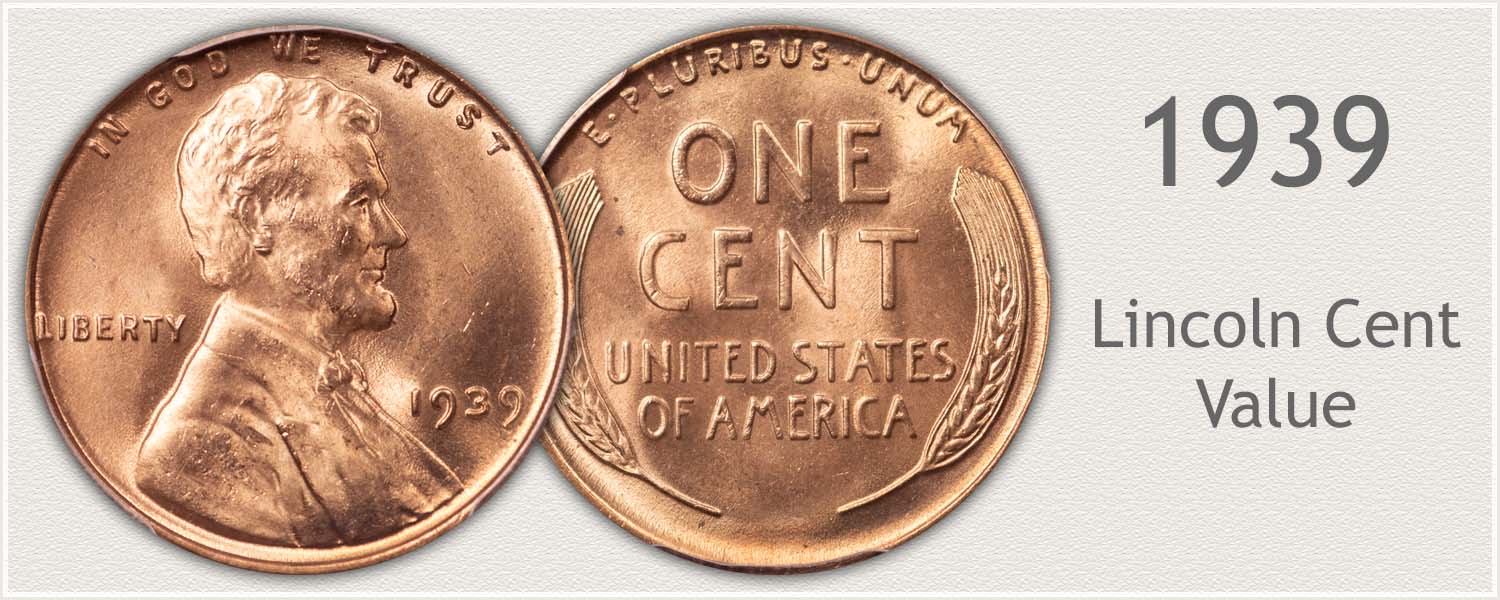
Steps Leading to Value:
- Step 1: Date and Mintmark Variety – Identify each date and its mintmark variety.
- Step 2: Grading Condition – Judge condition to determine grade.
- Step 3: Special Qualities – Certain elements either enhance or detract from value.
| 1939 Lincoln Penny Value | ||||
|---|---|---|---|---|
| Condition of Coin | ||||
| Date | Good | Fine | Extremely Fine | Uncirculated |
| 1939 Lincoln Penny Value Up-Dated | 2025 | |||
| 1939 | $0.06 | $0.11 | $0.13 | $3 |
| 1939 D | $0.08 | $0.45 | $0.69 | $6 |
| 1939 S | $0.08 | $0.15 | $0.26 | $4 |
Appraising a collection of coins are or a single wheat penny follows the same step by step method. Key information begins to narrow the range of potential worth.
Overall, identifying and judging three main factors brings you very close to an accurate value.
Date | Mint Mark | Condition
Staring with Date | Mint Mark: These identify the correct listing on the chart. Mints that struck the coin varied in numbers produced. The 1939 Denver the mint coin requires close study in Fine grade and above.
This leads to the Condition scale of values. Identify the correct range in the grading section, matching your coin to images of the different grades. Descriptions add subtle details to the grading process.
Step 1: | Date and Mintmark Combination
Identify 1939 Listing on Chart
Three varieties of cents were struck in 1939. Production of minor coinage continued to increase in 1939. One exception, the Denver mint was occupied with refining and coinage numbers were low.
1939 Lincoln Penny
No Mintmark Under Date: Philadelphia Mint Struck the Coin
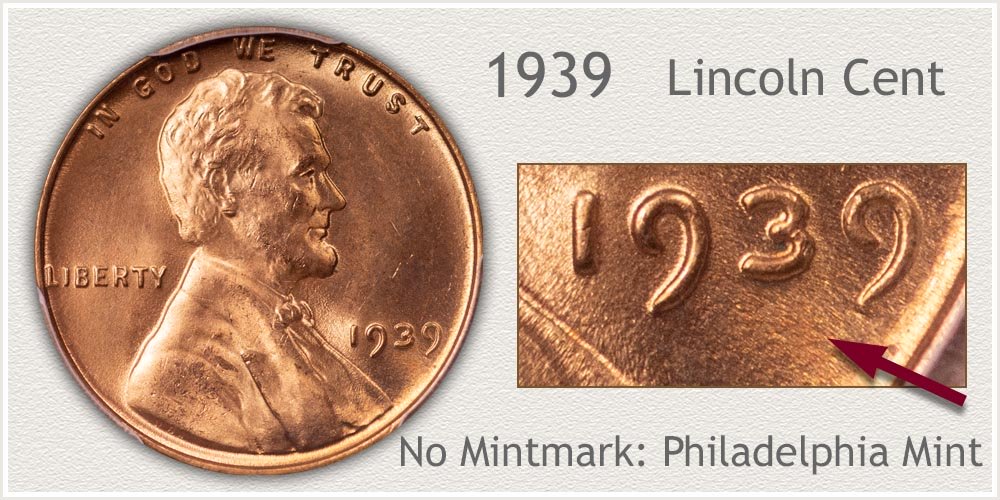
1939 Philadelphia wheat cents are widely available in circulated condition, Abundant on the rarity scale. Ample production to meet needs of commerce and saving by collectors at the time contributes to supply.
Any with strong details of Lincoln's portrait remaining are in the minority. Most continued in circulation until heavily worn. A bold bow-tie is indicating an upper end grade example.
1939-D Lincoln Penny
"D" Mintmark Under Date: Denver Mint Struck the Coin
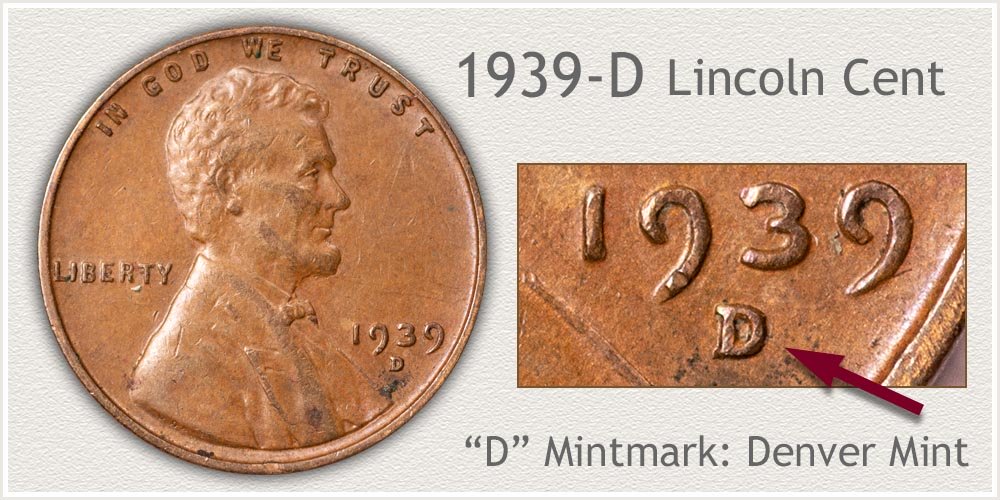
Denver production of cents in 1939 was the 9th lowest of the Denver mint variety wheat cent. 15,160,000 were struck. A premium value is noted of coins in above average condition.
Turn to the reverse, look closely at the upper ends of the wheat stalks. Fine lines were part of the original design, any remaining indicates a lightly circulated coin.
1939-S Lincoln Penny
"S" Mintmark Under Date: San Francisco Mint Struck the Coin
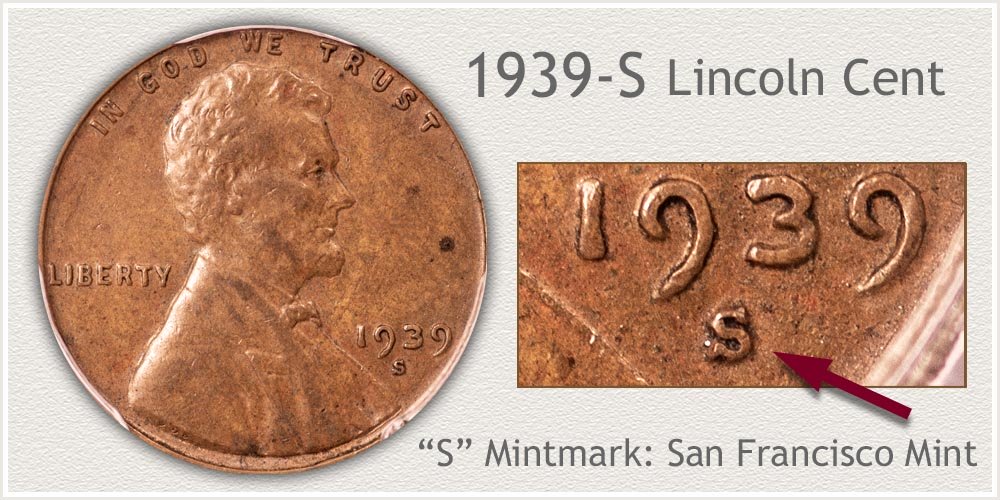
San Francisco 1939 wheat cents are Abundant on the rarity scale. Coins in worn condition make up the majority of examples available today. Collectors award a premium to pieces in Fine or better grade.
A 1939-S cent with crisp lettering along the rim is a nice find. Obverse letters sitting flat on the field is a well struck example, preferred by collectors.
Step 2: | Judge Condition to Identify Grade
Grading Confirms 1938 Lincoln Penny Value
Grade of a collectible coin is one part of the factors used in determining value. A coin's state of preservation in judged to arrive at a grade, a defining term used among collectors. Listed on the value chart are Grades ranging from Good to Uncirculated. Following are images used to identify the grade of wheat cents.
To identify an accurate value involves an accurate determination of grade. When viewing your coin first overall impression is important. Positive signs are even color and no distracting marks.
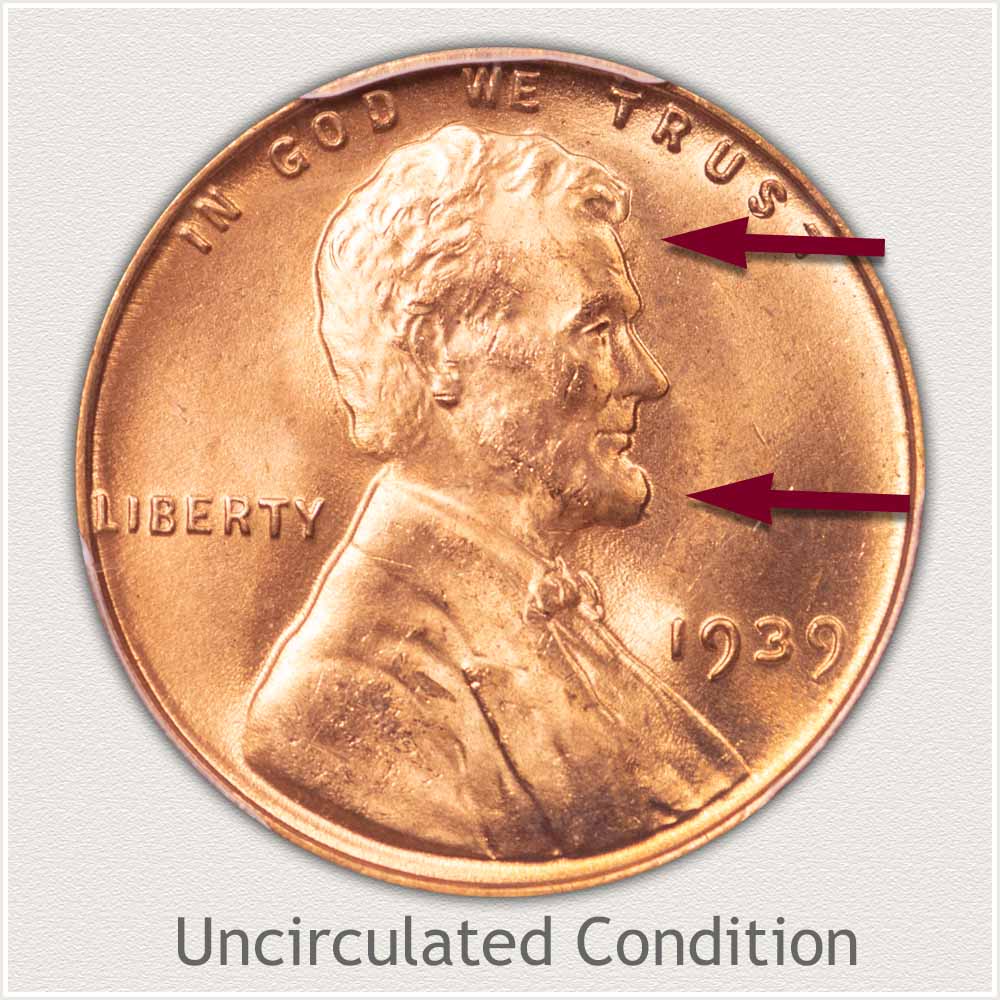
Uncirculated Grade: An uncirculated 1939 cent shows no signs of wear to any surface of design, legends, and fields. Mint frost, imparted at the time of striking remains undisturbed.
High in profile is an area starting at Lincoln's forehead, moving to his ear and downward along the jaw and ending at his chin. Luster composed of a fine texture covers these areas on a mint state coin. Smoothness indicates wear.
Even bright color is displayed by this penny. Original luster reflects from the high areas and lower fields. Any wear to these surfaces would dull the shine and smooth the delicate texture of the metal.
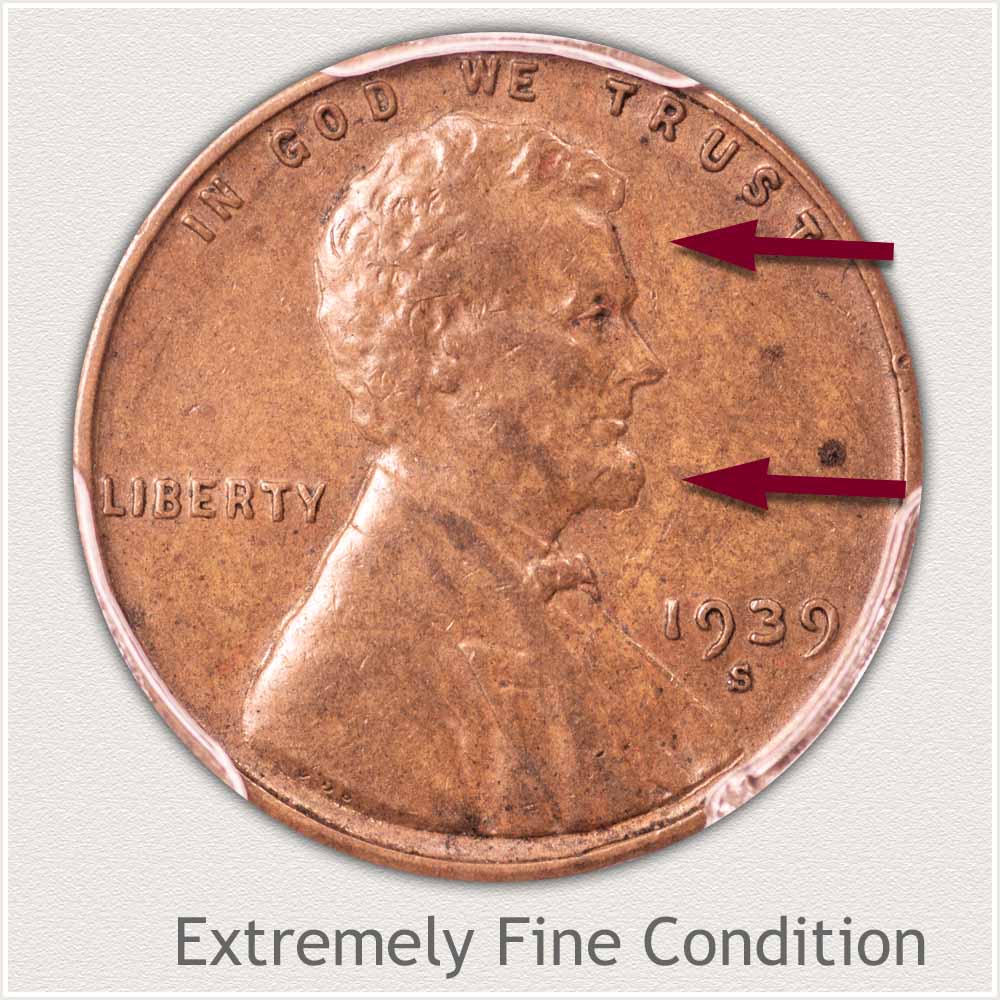
Extremely Fine Grade: After a time in circulation small areas of flatness begin to appear on the overall design. When collected, a grade of Extremely Fine is assigned to indicate its condition to other collectors.
Lincoln's forehead and temple is beginning to show smoothness. Hair behind the ear is noted with just a slight flattening to the upper most parts. A small flat area is noted on his jaw extending to the chin. All of these areas show wear, important is a remaining separation of major elements. Recognition of his ear is strong. Bold waves of hair remain.
A strong portrait of Lincoln shows ample detail in the extremely fine grade. Collectors seek and value wheat cents with eye appeal. Distracting marks are absent. Soft tans and brown colors highlight details on this collectible 1939-S penny.
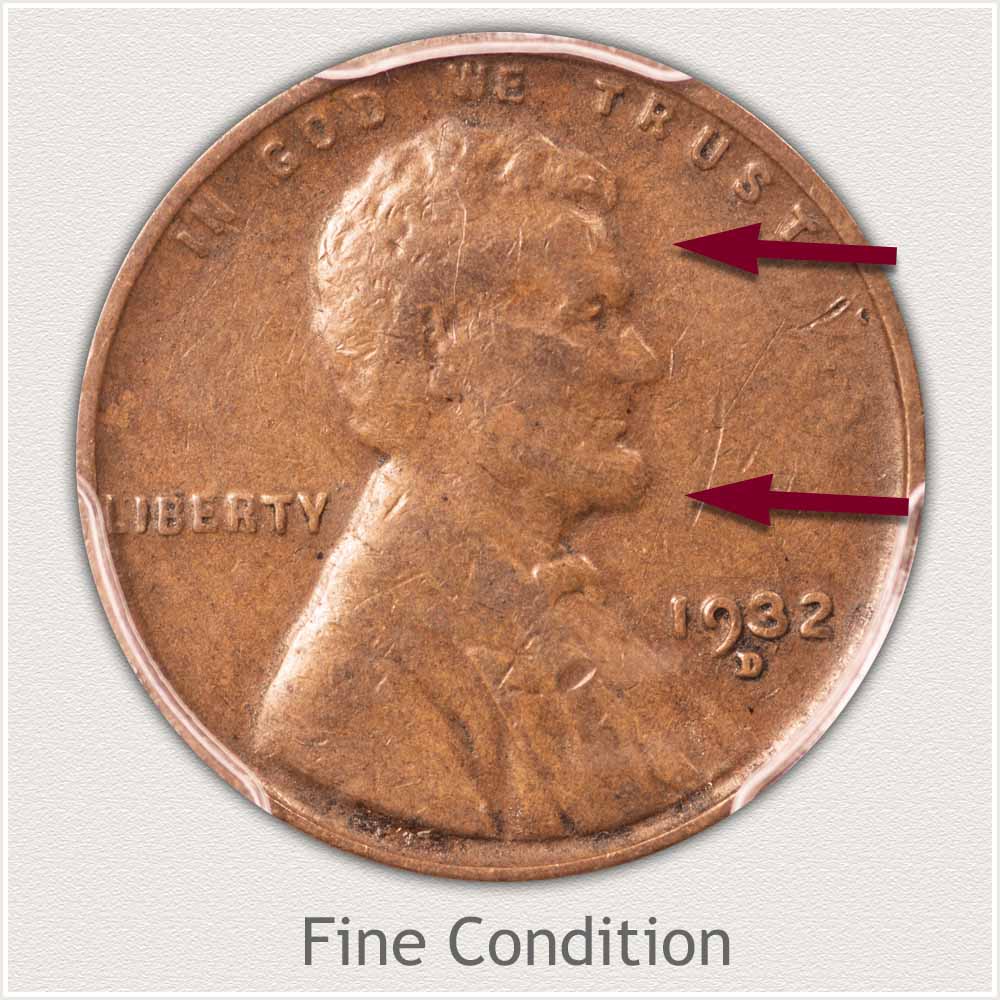
Fine Grade: Noticeable wear is a fist indicator of wheat pennies in Fine grade. Loss of metal from high areas along Lincoln's jaw are visible.
Wear is flattening the forehead and temple with an area just connecting to the hair line. Lincoln's ear is still visible just starting to merge with hair detail both above and behind. A small but visible flat area extends from the ear to the temple area. A once rounded jaw is flattened on the very top edge.
Despite spending time in circulation and loss of detail, bold and crisp lettering and date remain. A well-defined portrait is clear. Eye appeal, important to collectors, is also displayed by soft brown tones of color.
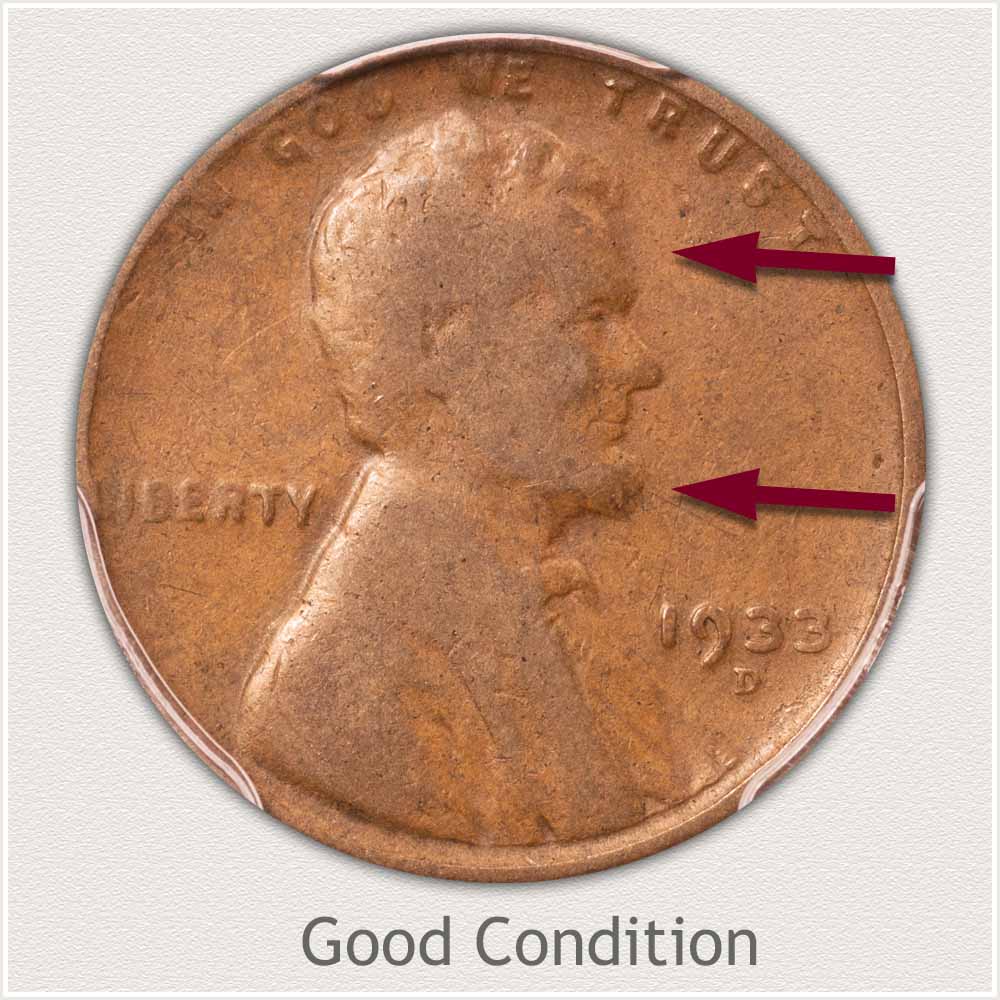
Good Grade: A typical wheat penny in Good grade is worn to the state of complete smoothness of all major features. Forehead leading to hair are one flat plane, Lincoln's cheek and ear have merged.
A close-up inspection of Lincoln's jaw shows little separation from the rest of his face. A slight contour remains defining the jaw from neck line. His chin is well raised from the field but is level with cheek.
A wheat cent in good grade often suffers from major distractions. Nicks and discoloration are among the main causes to lower the appeal of a heavily worn coin. Collectors take into consideration overall eye appeal when judging a candidate to add to a collection. Even toning over a mark-free surface is solid for the grade.
Video | Grading Lincoln Wheat Pennies
To further illustrate grading and pinpoint areas to consider Grading Lincoln Wheat Pennies. adds video, images, and descriptions to identify subtle details to condition. Many date and mintmark varieties of wheat pennies have large value ranges because of condition.
Step 3: | Special Qualities Enhancing Value
Collectible Error 1939 Lincoln Penny
A 1939 wheat cent is part of the second collecting area 1933 to 1958. Known for large quantities of cents available and affordable values. Circulated examples of these coins are an excellent choice to form a collection and enjoy finding pleasing examples.
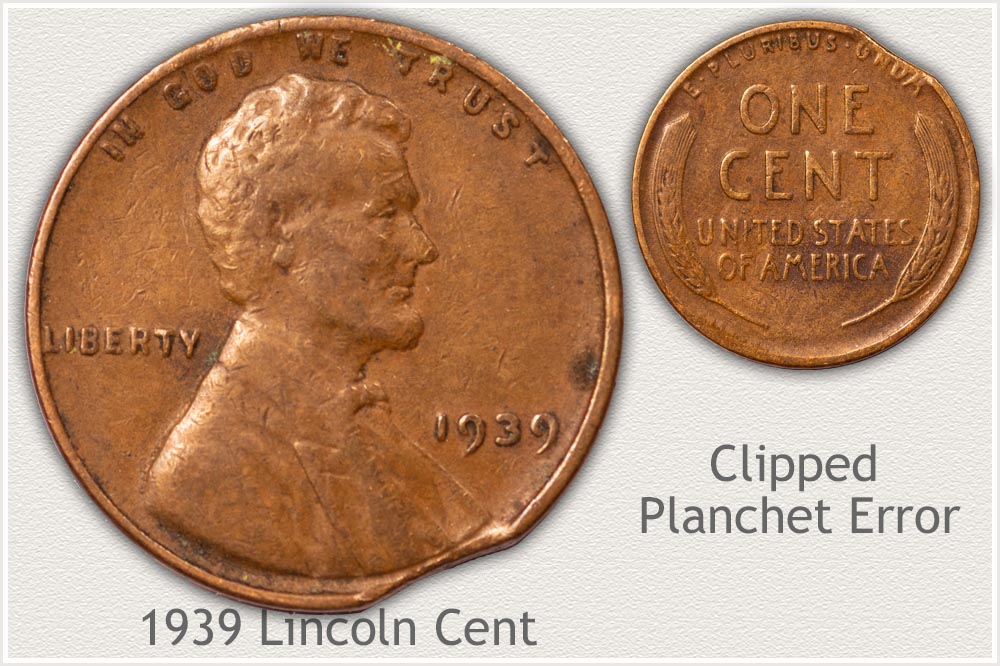
A close examination of the imaged 1939 penny shows a small missing section just below Lincoln. The curved cut left behind is the result of this coin, as a blank, was punched too near the void left by the previous blank. A machining error occurred and when struck an interesting mint error is the result. Worth a small premium in value. Larger clips are worth more if the date and enough of Lincoln's portrait remain. Eye appeal come into play with larger clipped planchet cents.
Inspect the edges and the metal within the clipped area, a consistent coloring and wear pattern covers both the surfaces of the coin and the inner curve of the clip. This quick check separates a coin cut outside the mint, not part of the minting process.
ReferencesUS Mint. 1940 US Mint Annual Report https://nnp.wustl.edu/library/publisherdetail/51
Coin Values | CoinStudy Articles
Value chart spans the Wheat design years 1909 through 1958 of Lincoln cents. From uncirculated coins collected by advances collectors to worn examples an affordable collection popular with young collectors. Identify date, mint and condition; a wide range of values is found and identified.
Storing your coins correctly preserves value. Single high value coins need protection from elements in the air and contact to their surfaces. Large quantities of coins are conveniently housed in special holders. Safe methods are explored.
★ Coin Values Discovery finds 1939 Penny Value and...
All US coin values. Recognize your old coins using the image links leading to value charts. Date | Mintmark | Condition are considered; all described and imaged within each series. Surprising value is often found in the smallest of detail.